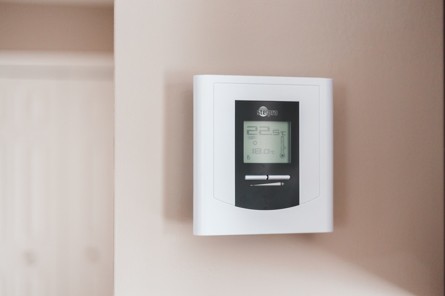It’s not uncommon for thermostats to fail, and we’ve all heard stories about how bad thermostats can make our homes miserable. But how do we tell if a thermostat is bad?
A bad thermostat messes up your HVAC system’s response to heating or cooling your home. This can lead to increased energy bills and, ultimately, the breakdown of your unit.
If you’re looking to save money and prevent costly repairs, you need to check your thermostat regularly. In this article, we will explain how to tell if your thermostat is bad and the best ways to deal with a faulty thermostat.
What is a Thermostat?
A thermostat is an electronic device that controls the temperature of your home. It’s usually installed in the wall or ceiling, and it uses sensors to detect when you are at home and when you aren’t.
Thermostats come in different types, shapes, and sizes. Some are small enough to fit inside a light switch; others look like old-fashioned mechanical clocks. The one thing they all share is that they control your home’s temperature by adjusting the flow of electricity.
There are different types of thermostats – non-programmable and programmable or smart thermostats, the former being the older types of thermostats.
How Should a Thermostat Work?
When you turn on the heat or air conditioning, a good thermostat sends a signal to the furnace or AC unit to adjust its cooling to your desired temperature.
Other functions of your thermostat may include:
-
Regulating the temperature of the device.
-
Keeping the cooling and heating system running till they complete a cycle
-
Detect the temperature of the room they’re in.
-
Transmit settings change to the system
The good news is that there are no technical skills required to install a new thermostat. You just need to follow the simple steps in your user manual.
Six Signs Thermostat is Bad in Your House
To know if you have a bad home thermostat, you can take a cue from how good thermostat temperature settings work; any sudden temperature changes from your cooling and heating system may point to a malfunctioning thermostat.
Here are some bad home thermostat symptoms that can help you understand how to tell if the thermostat is bad.
Wrong Temperature Reading
Your thermostat reads the temperature in the room to know how much cooling or heating you need. If you feel your room is cooler or hotter than it should be and your HVAC system is on, you may have a thermostat problem.
You can test for this by using an independent room temperature reader or thermometer. If the value on it differs from what your HVAC system displays, you should call an HVAC system professional to check it out.
Abnormally High Energy Costs
We all seek ways to reduce our monthly energy bills. However, if your thermostat fails, your energy bills may increase abnormally. A bad thermostat will cause your unit will use more energy to cool or heat your home.
You may not easily detect this, but a professional HVAC equipment engineer can check the thermostat housing and inform you if your thermostat needs to be changed.
Irregular On and Off of HVAC
Does your cooling equipment go off on its own? You may have a thermostat problem on your hands. The thermostat keeps the system on. So, If your HVAC system goes off, your thermostat may be sending the wrong message to the board and shutting off the system.
If this happens repeatedly, the thermostat may be broken or frayed. You should contact an HVAC expert to tell you if you need a thermostat change.
Thermostat’s Age
Generally, thermostats are expected to last for about ten years; however, consistent power surges can shorten the lifespan of this temperature gauge. Also, if your thermostat is an older version, it may run into problems sooner than the newer ones.
You don’t have to wait till your thermostat is faulty before checking its condition. Instead, call a professional air conditioner expert to check your system and install a compatible thermostat. You’ll have a more efficient home heating and cooling system with a programmable thermostat.
Failure to Respond to Changed Settings
When you increase the temperature on your system, but your room still feels cold, chances are your system’s thermostat isn’t working correctly.
This problem may be inconsistent, making you think you entered the wrong command. However, once you notice it’s happened a couple of times and you’re sure of what command you entered, give an air conditioning expert a call.
HVAC System Short Cycles
A complete HVAC cycle is when it brings the room’s temperature to what you have set it to. Usually, when a process is complete, the system goes to sleep until it picks up on a temperature change.
However, there’s a chance that your system may go to sleep before it reaches the set temperature, only to resume its cycle to that temperature; that’s short cycling.
Each time your system starts up again, it uses more energy than it does while running. Therefore, short cycling is one of the sure ways to tell if your system’s thermostat is terrible. Unfortunately, it also causes your energy bill to increase.
What Do You Do When You Have a Bad Home Thermostat?
You’ll be tempted to sort the problem of a bad thermostat in your house out as soon as possible because you’ll feel uncomfortable with the temperature, but that’s not the best route for a solution.
Don’t try to remove your thermostat unless you’re knowledgeable about heating and cooling systems. Instead, call a professional HVAC technician to check your system. They’ll tell you if you have more than a thermostat problem and provide better solutions.
Hire An HVAC Expert Today
The thermostat is vital to the proper functioning of your home’s heating and cooling systems. And although it’s expected to last for about ten years, it can become faulty before then.
As a resident in Spokane, WA, and surrounding areas, If you notice any of the signs explained in this article, you should contact Hurliman Heating. We will fix any issues with your thermostat and offer the best thermostat installation recommendations to keep your energy bills as low as possible.






